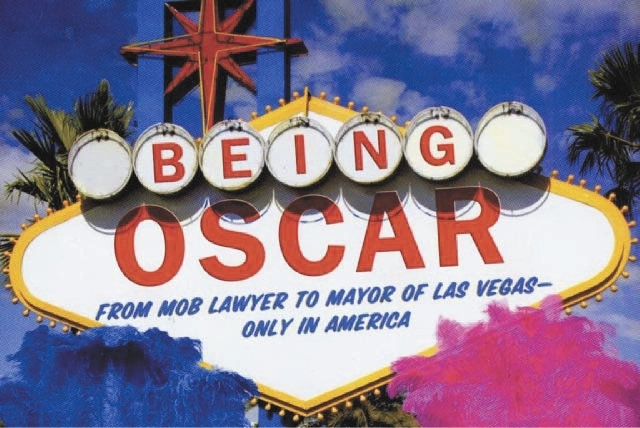Different truth from Oscar’s version

Memories are funny things. They’re not always true.
Oscar Goodman’s new book relates some memories that happened, but didn’t happen the way he recalled.
I know. I was there.
“Being Oscar” written with George Anastasia but in Goodman’s voice dwells on how the government folks were the bad guys and most of his clients were really the good guys.
On page 79, to prove his point about government overreaching, the book says, “Once I had a client who had been subpoenaed before a federal grand jury. I took him to the federal building and waited out in the grand jury room. In the hallway, up on the wall, there was a plaque with these caricatures.”
The disparaging caricatures included two federal judges as well as several of Goodman’s clients and Goodman. “This is what you saw when you were heading into the grand jury room. It was intimidating and frightening. The message was clear: If you won’t play ball and do what these guys want, you’re going to end up targeted and your face will be on that wall.”
It was true there were caricatures. But they weren’t even on the same floor as the grand jury room. They were in the Strike Force offices where no grand jurors went.
I covered that story and many others involving Goodman when I was the R-J’s federal court reporter from 1978 to 1984.
I doubt the ghost writer was changing the story, but I have no doubt that Goodman himself, who had to know better, took some literary license in order to advance his theme that government officials were the real bad guys and he was a hero who took them on and won.
The caricatures were silly and inappropriate and, yes, federal marshals did take them down. They are now part of the Mob Museum, which celebrated three days of adulation of Goodman, helping him promote his $26 book.
I had noticed in John L. Smith’s 2003 book “Of Rats and Men” that Goodman stretched the truth more than once. He claimed he wrote his own motions. As one who read those motions signed by “Annette Quintana for Oscar Goodman,” I was surprised he was so petty as to deny her the credit she deserved. Before her death, she declined to discuss it with me, but I thought it said something about Goodman’s eagerness to take all the credit, even at the expense of snubbing a loyal employee.
If there is a next edition, I suggest mobster Jimmy Fratianno’s name be spelled correctly. It’s not Fratiano. Hitman Andy Granby Hanley is actually Andy Gramby Hanley. It’s City Manager Betsy Fretwell, not Betty. And it’s businessman Dan Van Epp, not Don. There is no Las Vegas Cancer Institute but there was once a Nevada Cancer Institute.
I was particularly interested in the chapter “I Never Represented A Rat” since that was probably wrong.
In 2008, I broke the story that Frank “Lefty” Rosenthal had cooperated with the FBI during the time he was represented by Goodman. In an interview after I broke that, Goodman insisted he didn’t represent Rosenthal after the Rosenthals divorced in 1981. Newspaper clips easily showed that was blatantly false. How do you forget the decade you fought authorities to keep Rosenthal out of the Black Book?
In his book, Goodman does some tap dancing worthy of “Dancing With the Stars.”
“If there was such a thing as being a ‘dry snitch,’ Lefty might have been that. You know, someone who talks to the authorities, but not because he has a deal or is an informant but because he thinks he’s smarter than them or just wants to establish some kind of relationship,” Goodman said. “I don’t think he ever gave authorities any damaging information.”
But Goodman can’t possibly know, can he?
Goodman writes in sweeping generalities. He seldom provides names of government officials he charges were corrupt or overzealous. No local FBI agents or prosecutors are mentioned by name.
Yet in the final acknowledgement, he thanked “the handful of prosecutors who lived by the adage that achieving justice is more important than winning.” He doesn’t name them, naturally.
This second book about Oscar Goodman is strictly his memory. Not one other person is interviewed. If you expect complete accuracy and fresh insights, well, a lot of the mob stuff was already covered in Smith’s book. And Smith actually interviewed people besides Goodman.
Toward the end, where his 12 years as mayor are covered, Goodman said he got a mall developer to build downtown. Presumably he was talking about the Las Vegas Premium Outlets.
“Whenever I was asked, I would say, ‘It’s the best dollar-per-square-foot producing mall in America.’ Actually, I made that up. But it got repeated and took on a truth of its own. I was the mayor, and I could say whatever I wanted.”
It seemed to be the code he lives by.
In the “Being Oscar” prologue, Goodman’s ghost writer covered his tracks by saying others “will have their own versions of these stories. Oscar Goodman doesn’t care what they think. If they disagree, let them go write their own book.”
While I have no interest in writing a book about the mob lawyer turned mayor, it’s important people know that at least some of his recollections are more fantasy than fact. Just so you know.
Jane Ann Morrison’s column appears Monday, Thursday and Saturday. Email her at Jane@reviewjournal.com or call her at 702-383-0275.